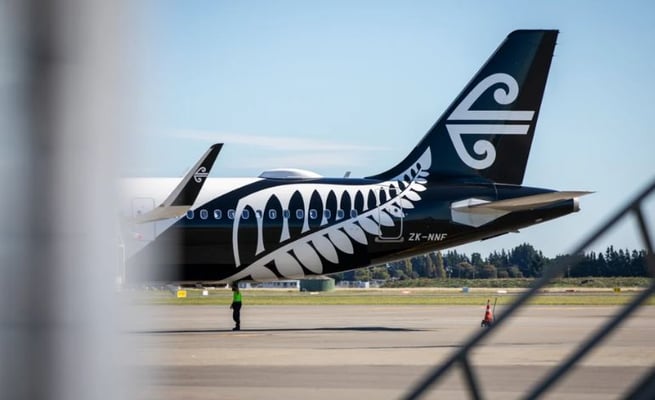Air New Zealand Reports 39% Drop In Half-Year Profit

Air New Zealand has reported a 39 percent drop in first half profit as demand constraints eased from the highs of last year.
Key numbers for the six months ended December compared with a year ago:
- Net profit $129m vs $213m
- Revenue $3.47b vs $3.08b
- Underlying profit $185m vs $299m
- Interim dividend 2 cents per share vs no dividend
Revenue rose 13 percent, driven by increased capacity across the international network.
The national carrier said demand has softened, particularly in domestic corporate and government travel since September.
The previous year saw the airline experience far greater demand for travel compared to the number of seats it had available, leading to higher fares for passengers.
"Inflationary pressures also continue to be felt. Non-fuel operating costs have increased around 5 percent or $100 million due to price inflation, which is on top of an increase totalling 15 to 20 percent across the last four years," the airline told the sharemarket.
As the airline had previously indicated, the result came in at the lower end of its guidance range of $180 million to $230m, and included $45m of Covid-related credits, which the airline said was "highly unlikely to be redeemed".
Chief executive Greg Foran said the engine maintenance requirements had also seen its aircraft spend more time on the ground.
"While this is beyond our control, we are managing these issues with changes to our schedule and additional leased aircraft," he said.
Air New Zealand said it has also faced "unprecedented competition" in North America and was experiencing pricing pressure from United States carriers.
The airline expected the second half of the financial year to be increasingly difficult, given the impact of its Pratt & Whitney engine maintenance requirements, economic risks, and softness in domestic demand.
The company forecast full year pre-tax earnings to be in the range of $200m to $240m, compared to the previous year's $585m.
Air New Zealand has reported a 39 percent drop in first half profit as demandconstraintseased from the highs of last year.
Key numbers for the six months ended December compared with a year ago:
- Net profit $129m vs $213m
- Revenue $3.47b vs $3.08b
- Underlying profit $185m vs $299m
- Interim dividend...
Air New Zealand has reported a 39 percent drop in first half profit as demand constraints eased from the highs of last year.
Key numbers for the six months ended December compared with a year ago:
- Net profit $129m vs $213m
- Revenue $3.47b vs $3.08b
- Underlying profit $185m vs $299m
- Interim dividend 2 cents per share vs no dividend
Revenue rose 13 percent, driven by increased capacity across the international network.
The national carrier said demand has softened, particularly in domestic corporate and government travel since September.
The previous year saw the airline experience far greater demand for travel compared to the number of seats it had available, leading to higher fares for passengers.
"Inflationary pressures also continue to be felt. Non-fuel operating costs have increased around 5 percent or $100 million due to price inflation, which is on top of an increase totalling 15 to 20 percent across the last four years," the airline told the sharemarket.
As the airline had previously indicated, the result came in at the lower end of its guidance range of $180 million to $230m, and included $45m of Covid-related credits, which the airline said was "highly unlikely to be redeemed".
Chief executive Greg Foran said the engine maintenance requirements had also seen its aircraft spend more time on the ground.
"While this is beyond our control, we are managing these issues with changes to our schedule and additional leased aircraft," he said.
Air New Zealand said it has also faced "unprecedented competition" in North America and was experiencing pricing pressure from United States carriers.
The airline expected the second half of the financial year to be increasingly difficult, given the impact of its Pratt & Whitney engine maintenance requirements, economic risks, and softness in domestic demand.
The company forecast full year pre-tax earnings to be in the range of $200m to $240m, compared to the previous year's $585m.










Leave a Comment